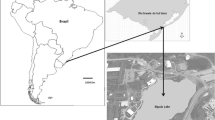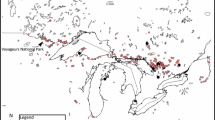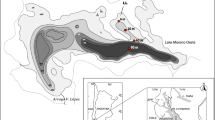Abstract
Macrozoobenthos of the ultraoligotrophic Lake 95 (61°N, 46°W, 8 ha, zmax=18 m,\(\bar z = 6.9 m\)) is composed of about 14 taxa dominated by 12 Chironomidae species. Abundance, life cycle, biomass and production were estimated for the six dominant taxa. Abundance declined fromca. 4150 at 2.5 m depth toca. 1400 ind m−2 at 16 m depth and averagedca. 3200 ind m−2 on a lakewide basis. By numbers,Heterotrissocladius changi andH. oliveri dominated the average fauna.H. changi was common at the 2.5 m and 5 m depth stations, whereasH. oliveri dominated from 5 m depth downwards. Chironomids showed mainly a 1-yr life cycle, but apparently bothHeterotrissocladius species had two contemporary cohorts with emergence in midsummer and late autumn/early spring, respectively. Average annual\({P \mathord{\left/ {\vphantom {P {\bar B}}} \right. \kern-\nulldelimiterspace} {\bar B}}\) ratio was 4.2 and 4.6 forH. oliveri andH. changi, respectively. Annual production varied from 0.3 g ash-free dry weight (AFDW) m−2 y−1 at 16 m depth to 1.6 g AFDW m−2 y−1 at 2.5 m depthH. changi contributed 45%, fiveMicropsectra spp. 17% andH. oliveri 15% to total average production, which on a lakewide basis wasca. 1.1 g AFDW or 25 kJ m−2 y−1. Lake 95 thus belongs at the very low end of measured lake zoobenthic productions, which range from 10 kJ m−2 y−1 in Arctic lakes toca. 1600 kJ m−2 y−1 in highly eutrophic shallow lakes.
Similar content being viewed by others
References
ALIMOV, A.F., V.V. BOULLION, N.P. FINOGENOVA, M.B. IVANOVA, N.K. KUZMITSKAYA, V.N. NIKULINA, N.G. OZERETSKOVSKAYA and T.W. ZHAROWA, 1972. Biological productivity of Lakes Krivoe and Krugloe. In: Z. Kajak and A. Hillbricht-Ilkowska, eds., Productivity problems of freshwaters. PWN Pol. Sci. Publ., Warsaw, p. 39–56.
ANDERSEN, F.S., 1937. Über die Metamorphose der Ceratopogoniden und Chironomiden Nordost-Grønlands. Medd. om Grønland 116, 1: 1–95.
ANDERSEN, F.S., 1946. East Greenland lakes as habitats for chironomid larvae. Studies on the systematics and biology of Chirononidae. Il. Medd. om Grønland 100 10: 1–65.
ANDRONIKOWA, I.N., V.G. DRABKOVA, K.N. KUZMENKO, N.F. MICHAILOVA and E.A. STRAVINSKAYA, 1972. Biological productivity of the main communities of the Red Lake. In: Z. Kajak and A. Hillbricht-Ilkowska, eds., Productivity problems of freshwaters. PWN Pol. Sco. Publ., Warsaw, p. 51–71.
BANSE, K. and S. MOSHER, 1980. Adult body mass and annual production/biomass relationships of field population Ecol. Monogr., 50: 355–379.
BRETSCHKO, G., 1974. The Chironomid fauna of a high-mountain lake (Vorderer Finstertaler See, Tyrol, Austria, 2237 m asl). Ent. Tidskr. 95, Suppl.: 22–33.
BRUNDIN, L., 1949. Chironomiden und andere Bodentiere der südschwedischen Urgebirgsseen. Rep. Inst. Freshwater Res. Drottningholm, 30: 1–914.
BRUNDIN, L., 1956. Die bodenfaunistischen Seetypen und ihre Anwendbarkeit auf die Südhalbkugel. Zugleich eine Theorie der produktionsbiologischen Bedeutung der glazialen Erosion. Rep. Inst. Freshwater Res. Drottningholm, 37: 192–235.
BUTLER, M.G., 1982. A 7-year life cycle for twoChironomus species in arctic Alaskan tundra ponds (Diptera: Chiromomidae). Can. J. Zool., 60: 58–70.
CUMMINS, K.W. and J.C. WUYCHECK, 1971. Caloric equivalents for investigations in ecological energetics. Mitt. Int. Ver. Limnol., 18: 1–158.
DANKS, H.V., 1981. Arctic arthropods. Ent. Soc. Canada. Ottowa.
ELLIOTT, J.M., 1977. Some methods for the statistical analysis of samples of benthic invertebrates. 2nd ed., Scient. Publ. Freshwat. Biol. Ass., 25: 1–160.
HOBBIE, J.E., 1973. Arctic limnology: A review. In: M.E. Britton, ed., Alaskan arctic tundra. Arct. Inst. N. Am., Tech. Pap., 25: 127–168.
JACKSON, G.A., 1977. Nearctic and PalaearcticParacladopelma Harnisch andSaetheria n. gen. (Diptera: Chironomidae). J. Fish. Res. Board Can., 34: 1321–1359.
KAJAK, Z., K. KACPRZAK and R. POLKOWSKI, 1965. Tube bottom sampler for taking samples of mikro and makro benthos, and for sampling of undisturbed structures of mud samples for experimental purposes. Ekol. Pol. (b), 11: 159–165.
LAVILLE, H. and N. GIANI, 1974. Phénologie et cycles biologiques des chironomides de la zone littorale (0–7 m) du lac de Port-Bielh (Pyrénées centrales). Ent. Tidskr. 95, Suppl. 139–155.
LINDEBERG, B. and T. WIEDERHOLM, 1979. Notes on the taxonomy of European species ofChironomus (Diptera: Chironomidae). Ent. Scand. Suppl., 10: 99–116.
LINDEGAARD, C., 1989. Secondary production of zoobenthos in freshwater ecosystems. A review with special reference to Chironomidae (Diptera). Acta Biol. Debr. Oecol. Hung., 3: 231–240.
LINDEGAARD, C., 1992. Zoobenthos ecology of Thingvallavatn: vertical distribution, abundance, population dynamics and production. Oikos, 64: 257–304.
LINDEGAARD, C. and P.M. JÓNASSON, 1978. Abundance, population dynamics and production of zoobenthos in Lake Myvatn, Iceland. Oikos, 32: 202–227.
LINDEGAARD, C., P. MÆHL and B.H. NIELSEN, 1978. Zoobenthos of lakes located within and outside the llímaussaq intrusion in South Greenland. Verh. Int. Ver. Limnol., 20: 159–164.
MACLEAN, S.F. Jr., 1973. Life cycle and growth energetics of the arctic crane flyPedicia hannai antenatta. Oikos 24: 436–443.
MOLLER PILOT, H.K.M., 1986. Opmerkingen over nomenklatuur en determinatie van Chironomidae. Nieuwsbr. Eur. Invertebrate Survey Nederl., 17: 33–35.
MÆHL, P., 1982. Phytoplankton production in relation to physico-chemical conditions in a small, oligotrophic subarctic lake in South Greenland.—Holarct. Ecol., 5: 420–427.
NYGAARD, G., 1979. Freshwater phytoplankton from the Narssaq Area, South Greenland. Bot. Tidsskrift, 73: 191–238.
OLIVER, D.R., 1964. A limnological investigation of a large arctic lake, Nettilling Lake, Baffin Island. Arctic, 17: 69–83.
PECHLANER, R., G. BRETSCHKO, P. GOLLMANN, H. PFEIFER, M. TILZER and H.P. WEISSENBACH, 1972. The production processes in two high-mountain lakes (Vorderer and Hinterer Finstertaler See, Kühtai, Austria). In: Z. Kajak and A. Hillbricht-Ilkowska, eds., Productivity problems of freshwaters. PWN Pol. Sci. Publ., Warsaw, p. 239–269.
PINDER, L.C.V. and F. REISS, 1983. 10. The larvae of Chironominae (Diptera: Chironomidae) of the Holarctic region—Keys and diagnoses. Ent. scand. Suppl., 19: 293–435.
RIGLER, F.H., 1978. Limnology in the high Arctic: a case study of Char Lake. Verh. Inter. Ver. Limnol., 20: 127–140.
SÆTHER, O.A., 1975. Nearctic and palaearcticHeterotrissocladius (Diptera: Chironomidae). Bull. Fish. Res. Board Can., 193: 1–67.
SÆTHER, O.A., 1979. Chironomid communities as water quality indicators. Holarct. Ecol., 2: 65–74.
SÄWEDAL, L., 1979.Micropsectra brundini n. sp. (Diptera: Chironomidae) and geographical variation in theMicropsectra insignilobus aggregate.—Ent. Scand. Suppl., 10: 133–138.
SÄWEDAL, L., 1981. Description ofMicropsectra tori n. sp. from Greenland, with notes on therecurvata-group (Diptera: Chironomidae). Ent. Scand., 12: 27–30.
STEINBÖCK, O., 1955. Über die Verhältnisse in der tiefe der Hochgebirgsseen. Mem. Inst. Ital. Idrobiol., Suppl. 8: 311–343.
STRAYER, D. and G.E. LIKENS, 1986. An energy budget for the zoobenthos of Mirror Lake, New Hampshire, Ecology, 67: 303–313.
WATERS, T.F., 1977. Secondary production in inland waters. Adv. Ecol. Res., 10: 91–164.
WELCH, H.E., 1976. Ecology of Chironomidae (Diptera) in a polar lake. J. Fish. Res. Board Can., 33: 227–247.
WINBERG, G.G., 1971. Methods for the estimation of production of aquatic animals. Academic Press, London.
WINBERG, G.G., A.F. ALIMOV, V.V. BOULLION, M.B. IVANOVA, E.V. KOROBTZOVA, N.K. KUZMITSKAYA, V.N. NIKULINA, N.P. FINOGENOVA and M.V. FURSENKO, 1973. Biological productivity of two subarctic lakes. Freshwat. Biol., 3: 177–197.
Author information
Authors and Affiliations
Rights and permissions
About this article
Cite this article
Lindegaard, C., Mæhl, P. Abundance, population dynamics and production of Chironomidae (Diptera) in an ul traoligotrophic lake in South Greenland. Netherlands Journal of Aquatic Ecology 26, 297–308 (1992). https://doi.org/10.1007/BF02255255
Issue Date:
DOI: https://doi.org/10.1007/BF02255255




